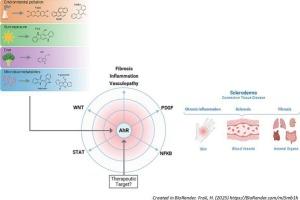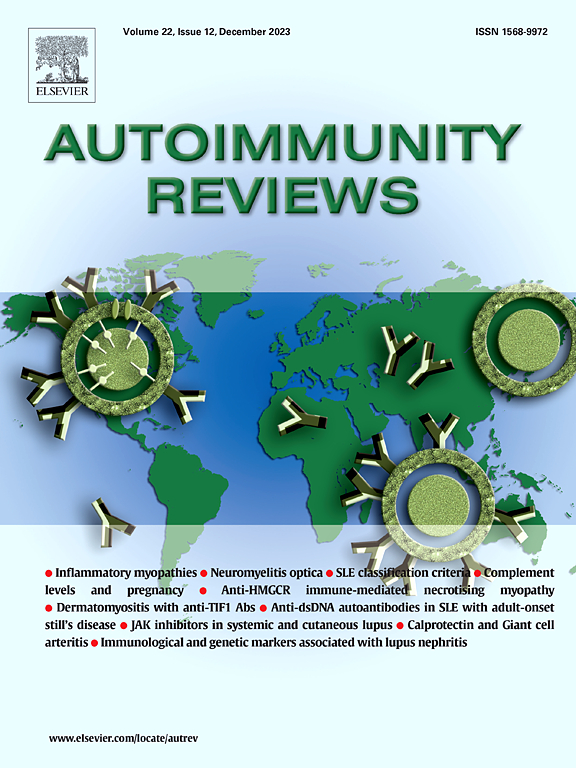系统性硬化和AHR:揭示隐藏的联系
IF 8.3
1区 医学
Q1 IMMUNOLOGY
引用次数: 0
摘要
系统性硬化症(SSc)是一种复杂的、使人衰弱的自身免疫性疾病,其特征是皮肤和内脏纤维化,同时伴有慢性炎症和血管异常。SSc的发病机制涉及遗传和环境因素,如二氧化硅粉尘或苯暴露,但调节纤维发生和器官受损伤的潜在分子机制尚不完全清楚。部分由于这种知识差距,治疗选择是有限的。在这篇综述中,我们着眼于芳烃受体(AHR)的可能作用,芳烃受体是一种转录因子,参与免疫调节、纤维化、药物代谢和炎症反应,特别是在屏障器官中。AHR通过与其众多小分子量配体中的一种结合而激活,可导致细胞核中基因表达的变化(其作为转录因子的作用),但也会通过直接结合(例如,与NFkB)或通过AHR的蛋白质降解能力(E3连接酶)对其他信号通路产生连锁反应。在某些细胞类型中,转录靶基因包括纤维化细胞因子TGF-β或负责细胞外基质重塑的金属蛋白酶。AHR已被证明在所有皮肤细胞群中高度表达,并且对皮肤稳态至关重要。鉴于其上下文依赖效应,AHR可能在SSc中作为促纤维化和抗纤维化调节剂,这取决于配体的可用性和细胞环境。这种双重作用突出了AHR作为潜在的治疗靶点,选择性激动剂或拮抗剂可以帮助恢复免疫和纤维化的稳态。在这里,我们探讨了这些机制,并讨论了AHR作为调节疾病进展和改善患者预后的治疗靶点的潜力。本文章由计算机程序翻译,如有差异,请以英文原文为准。

Systemic sclerosis and AHR: Shedding light on a hidden connections
Systemic sclerosis (SSc) is a complex and debilitating autoimmune disease marked by fibrosis of the skin and inner organs, alongside chronic inflammation, and vascular abnormalities. SSc pathogenesis involves both genetic and environmental factors, such as silica dust or benzene exposure but the underlying molecular mechanisms regulating fibrogenesis and organ involvement are not fully understood. In part due to this knowledge gap, treatment options are limited. In this review we look at the possible role of the aryl hydrocarbon receptor (AHR), a transcription factor involved in immunomodulation, fibrosis and drug metabolism and inflammatory responses, especially in barrier organs. AHR activation by binding to one of its many small molecular weight ligands can result in gene-expression changes in the nucleus (its role as a transcription factor) but also lead to knock-on effects on other signaling pathways via direct binding (e.g., to NFkB) or via AHR's protein degradation capacity (E3 ligase). In some cell types transcription target genes include the fibrogenic cytokine TGF-β or metalloproteinases responsible for extracellular matrix remodeling. AHR has been shown to be highly expressed in all cutaneous cell populations, and to be critical for skin homeostasis. Given its context-dependent effects, AHR may act as both a pro- and anti-fibrotic regulator in SSc, depending on ligand availability and cellular environment. This dual role highlights AHR as a potential therapeutic target, where selective agonists or antagonists could help restore immune and fibrotic homeostasis. Here, we explore these mechanisms and discuss the potential of AHR as a therapeutic target for modulating disease progression and improving patient outcomes.
求助全文
通过发布文献求助,成功后即可免费获取论文全文。
去求助
来源期刊

Autoimmunity reviews
医学-免疫学
CiteScore
24.70
自引率
4.40%
发文量
164
审稿时长
21 days
期刊介绍:
Autoimmunity Reviews is a publication that features up-to-date, structured reviews on various topics in the field of autoimmunity. These reviews are written by renowned experts and include demonstrative illustrations and tables. Each article will have a clear "take-home" message for readers.
The selection of articles is primarily done by the Editors-in-Chief, based on recommendations from the international Editorial Board. The topics covered in the articles span all areas of autoimmunology, aiming to bridge the gap between basic and clinical sciences.
In terms of content, the contributions in basic sciences delve into the pathophysiology and mechanisms of autoimmune disorders, as well as genomics and proteomics. On the other hand, clinical contributions focus on diseases related to autoimmunity, novel therapies, and clinical associations.
Autoimmunity Reviews is internationally recognized, and its articles are indexed and abstracted in prestigious databases such as PubMed/Medline, Science Citation Index Expanded, Biosciences Information Services, and Chemical Abstracts.
 求助内容:
求助内容: 应助结果提醒方式:
应助结果提醒方式:


